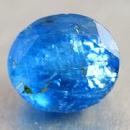|
ClassicGems.net |
|
|
 |
|
Afghanite |
|
|
Discovered in 1968; IMA status: Valid (IMA approved 1968) |
|||
|
|
|
Chemistry |
|
|
|
|
|
(Na,Ca,K)8(Si,Al)12O24(SO4,Cl,CO3)3 · H2O |
|
|
|
Hydrated Sodium Calcium Potassium Aluminum Silicate Carbonate |
|
Molecular Weight: |
1,200.45 gm |
|
Composition: |
Potassium |
2.28 % |
K |
2.75 % |
K2O |
|
|
Sodium |
9.19 % |
Na |
12.39 % |
Na2O |
|
|
Calcium |
11.69 % |
Ca |
16.35 % |
CaO |
|
|
Aluminum |
13.26 % |
Al |
25.06 % |
Al2O3 |
|
|
Silicon |
14.27 % |
Si |
30.53 % |
SiO2 |
|
|
Hydrogen |
0.08 % |
H |
0.75 % |
H2O |
|
|
Carbon |
0.10 % |
C |
0.37 % |
CO2 |
|
|
Sulfur |
3.39 % |
S |
8.47 % |
SO3 |
|
|
Chlorine |
4.58 % |
Cl |
4.58 % |
Cl |
|
|
|
— % |
Cl |
—1.03 % |
—O=Cl2 |
|
|
Oxygen |
41.16 % |
O |
|
|
|
|
|
100.00 % |
|
100.00 % |
= TOTAL OXIDE |
|
|
|
||||
|
Classification |
|
|
|
|
|
Silicates (Germanates) |
|
|
8/J.09-50 |
|
|
|
9 : SILICATES (Germanates)
|
|
Related to: |
Cancrinite Group |
|
Members of Group: |
Cancrinite Group: Afghanite, Allorite, Biachellaite, Bystrite, Cancrinite, Cancrisilite, Davyne, Depmeierite, Franzinite, Giuseppetite, Hydroxycancrinite, Kircherite, Kyanoxalite, Liottite, Marinellite, Microsommite, Pitiglianoite, Quadridavyne, Sacrofanite, Tounkite, Vishnevite |
|
Varieties: |
None |
|
Synonyms: |
IMA1967-041 |
|
|
|
|
Crystal Data |
|
|
|
|
|
As stout to slender, thin tabular laths and as rounded grains or as massive - uniformly indistinguishable crystals forming large masses. |
|
|
None |
|
|
|
|
|
Physical Properties |
|
|
|
|
|
Perfect on [1010] |
|
|
Conchoidal |
|
|
Brittle |
|
|
5.5 - 6.0 |
|
|
2.55 - 2.65 (g/cm3) |
|
|
None |
|
|
Barely Detectable; GRapi = 32.54 (Gamma Ray American Petroleum Institute Units) |
|
|
|
|
|
Optical Properties |
|
|
|
|
|
Light Blue to Dark Blue, Colorless |
|
|
Transparent |
|
|
Vitreous |
|
|
1.523 - 1.529 Uniaxial ( + ) |
|
|
0.006 |
|
|
n/a |
|
|
None |
|
|
|
|
|
Occurances |
|
|
|
|
|
Geological Setting: |
In thin veinlets cutting lazurite crystals (Sar-e-Sang, Afghanistan); in silicifed limestone xenoliths in pumice (Pitigliano quarry, Italy). |
|
Common Associations: |
Lazurite, Sodalite, Nepheline, Phlogopite, Olivine, Diopside, Vesuvianite, Calcite, Pyrite. |
|
Common Impurities: |
None |
|
Type Locality: |
Lapis-lazuli Mine, Sar-e-Sang, Badakhshan (Badakshan; Badahsan) Province, Afghanistan |
|
Year Discovered: |
1968 |
|
View mineral photos: |
|
|
|
|
|
More Information |
|
|
|
|
|
|
|
|
|
|
|
Afghanite is is a rare Feldspathoid mineral of the Cancrinite Group of minerals and is found in only a few locations worldwide. It is usually found associated with Lazurite and Sodalite. Crystals are blue to dark blue and usually moderately to heavily included. Gems are typically small and included but beautiful shades of saturated blue. Afghanite was discovered in 1968 in the Lapis-lazuli Mine, Sar-e-Sang, Badakhshan Province, Afghanistan and takes its name from that country. Afghanite is named after the country of its discovery. It was discovered at the Lapis-lazuli Mine, Sar-e-Sang, Badakhshan Province, Afghanistan. Locations for Afghanite: at Sar-e-Sang, Badakhshan Province, Afghanistan. In Russia, in the Malaya Bystraya and Tultuy lazurite deposits, near Lake Baikal, and in other unspecified deposits in eastern Siberia. From Lyadzhuar-Darinsk, Pamir Mountains, Tajikistan. In Italy, at the Pitigliano quarry, near Grosseto, Tuscany; on Monte Somma, Campania; from Vetralla and Bassano, Latium. In the Edwards mine, Edwards, St. Lawrence County, New York, USA. At Lake Harbour, Bafin Island, Newfoundland, Canada. |
|
|
Afghanite gems for sale: We have not photographed the Afghanite gems yet. Please check back soon. |